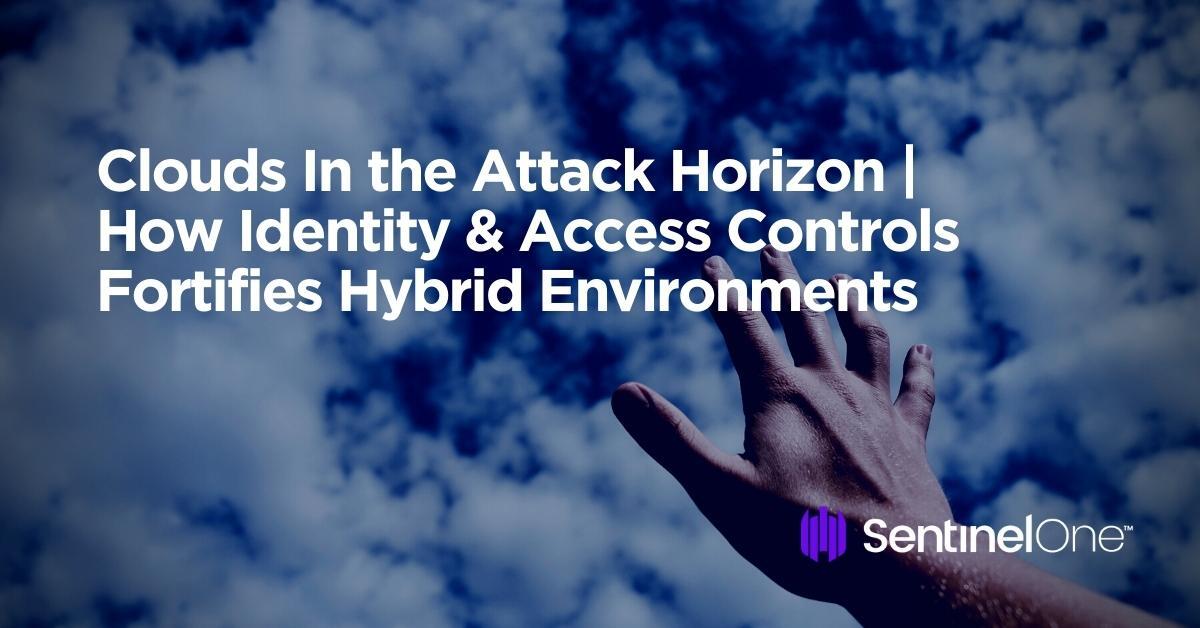Modern enterprises have rapidly adopted hybrid cloud environments to harness the benefits of both on-prem infrastructure and public cloud services. With higher rates of adoption and nearly half of all breaches occurring in the cloud, the question of how to secure this growing hybrid cloud landscape has become a top priority for business leaders.
One significant aspect of securing hybrid clouds is effectively managing identity and access controls. Since identity and access provide the framework and controls to authenticate and authorize user access, understanding them in the context of hybrid clouds is a critical element in establishing a secure environment.
In hybrid cloud deployments where resources are distributed across on-prem and cloud platforms, managing identities can be a challenge for security teams. This blog post covers how security teams and business leaders can combine identity and access control best practices with advanced detection and response capabilities to ensure robust security for their hybrid cloud environments.

Understanding Identity & Access Management In Cloud Security
Identity and access controls are essential measures in the fight against cyberattacks. They involve the processes used to authenticate and authorize user access to resources within an organization’s data infrastructure. Through strong identity and access controls, organizations can establish a robust security framework that helps prevent unauthorized access and mitigate the risk of breaches and cloud ransomware attacks.
Identity and access controls ensure that only authenticated and authorized individuals can access sensitive information, systems, and resources. Effective controls also enable organizations to enforce least privilege principles, limiting user access to only what they need to for their specific roles. Maintaining granular control over user permissions means security teams can reduce the attack surface and protect against insider attacks, data breaches, and attacks involving privilege escalation.
When it comes to the digital infrastructure, organizations must consider all fronts: on-prem, public cloud, and hybrid cloud environments:
- On-premises (on-prem) refers to infrastructure that is owned and managed directly by the organization within its premises.
- Public cloud involves utilizing resources and services provided by third-party cloud service providers (CSPs) over the internet.
- Hybrid cloud combines both on-prem and public cloud components, allowing organizations to leverage the benefits of both.
While on-prem offers full control and customization, it requires significant upfront investment and ongoing maintenance. Public cloud offers scalability, flexibility, and cost-effectiveness, but data privacy and compliance concerns may arise. This in mind, hybrid clouds have become a popular option as they provide a balance by allowing organizations to leverage existing investments while utilizing the scalability and flexibility of the public cloud for specific workloads. Understanding these differences is crucial for organizations to make informed decisions about their infrastructure security.
Key Components of Identity & Access Controls For Hybrid Clouds
Effective management of identity and access controls is crucial in securing hybrid cloud environments. To establish a robust security framework, several key components need to be considered.
Identity Management Systems
Identity management systems play a pivotal role in managing user identities and access rights across hybrid cloud environments. These systems provide a centralized approach to identity management, enabling organizations to streamline user provisioning, authentication, and deprovisioning processes. With a unified identity management system in place, organizations have the capability to enforce password policies, implement multi-factor authentication (MFA), and efficiently manage user lifecycle events across hybrid cloud platforms.
Centralized identity management ensures consistent access control policies throughout the hybrid cloud infrastructure and reduces the risk of unauthorized access or compromised credentials. Also, it simplifies the administration of user identities, giving security teams greater visibility and control over user access privileges. Organizations with a unified identity management system in place are much better positioned to achieve a higher level of security, streamline user management processes, and ensure compliance with any industry-specific regulations.
Authentication Mechanisms
Authentication mechanisms are the gatekeepers along the path to accessing resources in hybrid cloud environments. Organizations must carefully evaluate and implement appropriate authentication methods to strengthen security. While traditional methods like passwords are still often used, they are no longer considered sufficient protection on their own. Advanced techniques such as digital certificates, biometrics, or token-based authentication offer stronger security measures.
One of the most effective authentication mechanisms in hybrid cloud environments is multi-factor authentication (MFA). MFA requires users to provide multiple pieces of evidence to verify their identities. By combining something the user knows (such as a password) with something they have (like a physical token) or something they are (biometrics), MFA significantly elevates the security posture of hybrid cloud deployments. Even if one factor is compromised, the additional layers of authentication provide an added layer of defense against unauthorized access.
Implementing strong authentication mechanisms in hybrid clouds ensures that only authorized users can access resources, minimizing the risk of credential theft and unauthorized account access. Organizations should choose authentication methods that align with their security requirements and strike the right balance between usability and protection.
Role-Based Access Control (RBAC)
Role-Based Access Control (RBAC) is a widely adopted authorization model that simplifies access management in hybrid cloud environments. RBAC associates permissions with predefined roles, rather than with specific individuals in the organization. In this approach, security teams work with leadership to assign and approve permissions based on job responsibilities. This ensures that users have access only to the resources necessary for their assigned roles.
In terms of protecting hybrid clouds, RBAC helps maintain consistent access control policies across different platforms, simplifying user privilege management. By implementing RBAC, organizations can reduce their overhead costs by managing access at a role level rather than assigning individual permissions to each user which is arduous and leaves too much room for error or oversight. This granular control is designed to lessen the risk of excessive privileges and unauthorized access – two issues that commonly threaten the overall security posture of hybrid cloud deployments.
Identity Threat Detection & Response (ITDR)
As the number of digital identities continues to grow exponentially, opportunistic threat actors have seized this expanding surface as a prime target for cyberattacks. Identity-based cyber threats have surged, challenging conventional identity management tools like Identity Access Management (IAM), Privileged Access Management (PAM), and Identity Governance and Administration (IGA). These solutions alone are insufficient to shield organizations from the evolving cyber threats targeting both digital and machine identities.
To combat the rising risks and safeguard their enterprises, many organizations are now turning to a combination of identity threat detection and response (ITDR) strategies. By employing ITDR alongside traditional identity management tools, organizations can bolster their defense against advanced cyber threats, mitigate risks, and fortify their security posture effectively.
Managing Identity & Access Controls in Hybrid Clouds
Managing identity and access controls in hybrid cloud environments requires a proactive approach. By following best practices, security teams can establish a robust framework to protect business-critical resources and data effectively.
Establish the Principle of Least Privilege (PoLP)
The Principle of Least Privilege (PoLP) is a fundamental security principle that applies to all IT environments, including hybrid clouds. It dictates that users should only be granted the minimum level of access necessary to perform their job responsibilities. Applying the PoLP ensures that individuals have access only to the resources they need and reduces the risk of unauthorized access or accidental misuse of privileges.
To implement the PoLP in hybrid cloud environments, organizations should conduct regular access reviews to evaluate user permissions and ensure they align with current roles and responsibilities. Also, consider implementing just-in-time (JIT) access where privileges are granted for a limited time when needed and revoked afterward.
Perform Continuous Monitoring & Auditing
Continuous monitoring and auditing are a core pillar in maintaining the security of identity and access controls in hybrid cloud environments. Monitoring user activities is the first step to detecting and responding to potential security incidents in real-time as well as reducing the time needed to identify and mitigate threats.
Continuous monitoring involves collecting and analyzing security logs and events from various sources, including identity management systems, authentication systems, and access control mechanisms. This enables security analysts to identify atypical behavior within hybrid clouds, such as unusual login patterns or unauthorized access attempts, and take the right actions promptly.
In addition to monitoring, regular auditing is essential to evaluate the effectiveness of identity and access controls and ensure they are in compliance with regulatory requirements. Auditing involves reviewing user permissions, access logs, and system configurations to identify any vulnerabilities or discrepancies. Having a firm auditing policy in place helps organizations to identify and address security gaps and demonstrate adherence to industry standards and compliance regulations.
Combine Advanced Endpoint Protection With ITDR
In the shifting threat landscape, identity threat detection and response (ITDR) continues to emerge, complementing advanced security solutions like Endpoint Detection and Response (EDR) and Extended Detection and Response (XDR). ITDR focuses on safeguarding credentials, privileges, cloud entitlements, and the systems that govern them, bridging a significant gap in the security realm. By implementing ITDR, organizations can:
- Protect cloud environments – Cloud infrastructures can present permissions sprawl, overwhelming teams with numerous applications, containers, and servers to manage. ITDR solutions extend their protective umbrella to cloud environments, offering visibility into risky entitlements that could attract opportunistic attackers.
- Detect & Prevent Identity-Based Attacks – ITDR actively seeks out attacks targeting identity vectors, swiftly identifying credential theft, signs of privilege misuse, and malicious activities on Active Directory (AD) and other systems.
- Thwart The Attack Lifecycle – ITDR solutions add an extra layer of protection by deploying pre-set decoys to divert attackers, automatically isolating affected systems, and preventing lateral movement into other networks.
- Build Lasting Cyber Resilience – ITDR proves its value in forensic data collection, gathering critical telemetry on attack processes. The gathered threat intelligence empowers technical teams to fortify weak policies and processes, enhancing long-term cyber resilience.
Conclusion
Hybrid clouds are often targeted by cyberattacks due to their unique complexities and increased attack surface. Exploiting potential misconfigurations, weak authentication mechanisms, and synchronization issues between different platforms, threat actors increasingly have their eyes set on hybrid clouds as a lucrative attack vector.
In the face of relentless identity-based threats affecting industries worldwide, business leaders are intensifying efforts to mitigate these risks with a more proactive approach. By centering their focus on identity and access protection, organizations can fortify their hybrid cloud deployments against unauthorized access attempts, minimize the risk of compromised credentials, and establish a foundation of trust and security across the infrastructure.
SentinelOne has leveraged its deep experience in privilege escalation and lateral movement detection to become a significant player in the ITDR space. Learn about SentinelOne’s approach defending hybrid cloud environments by contacting us or booking a demo today.


